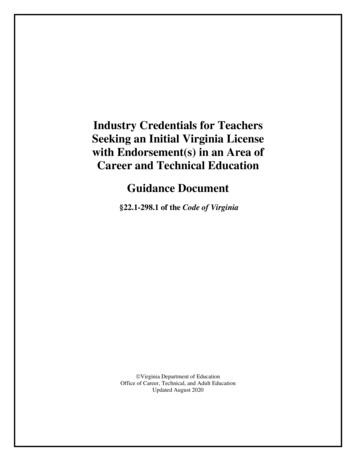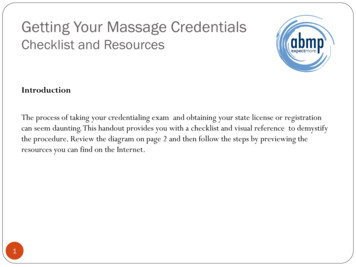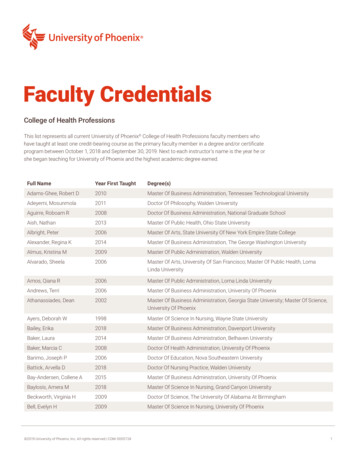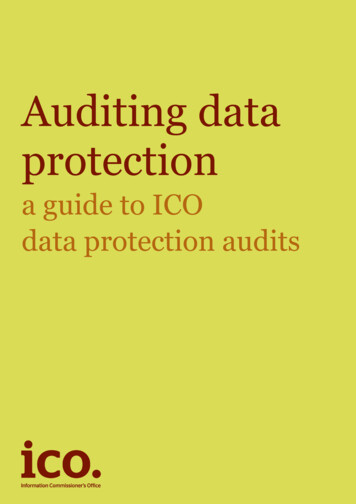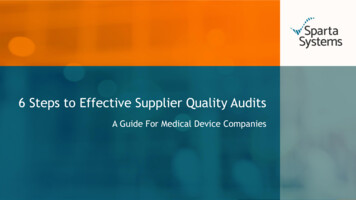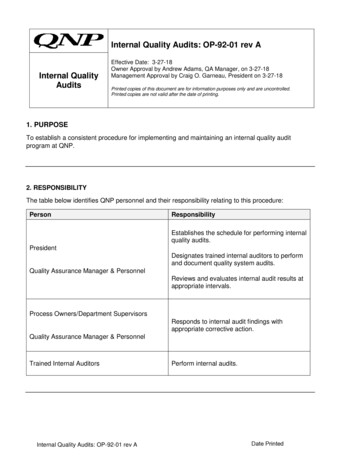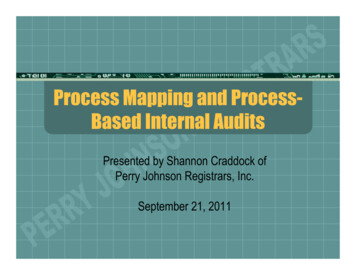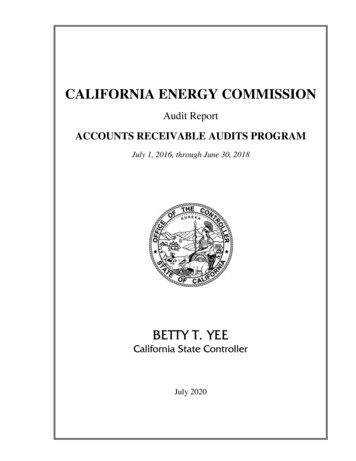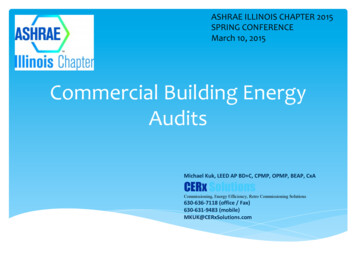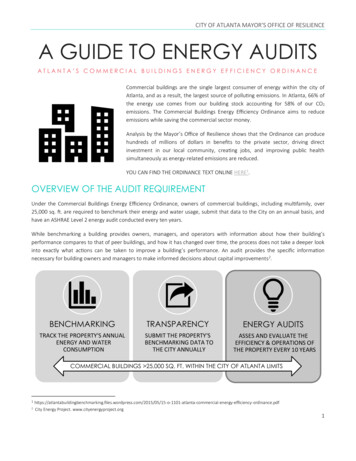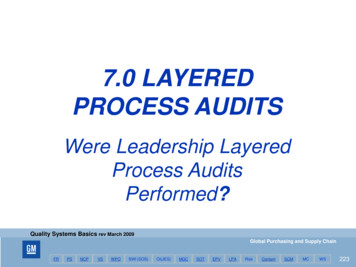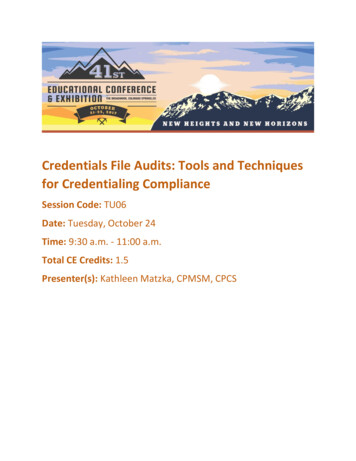
Transcription
Credentials File Audits: Tools and Techniquesfor Credentialing ComplianceSession Code: TU06Date: Tuesday, October 24Time: 9:30 a.m. - 11:00 a.m.Total CE Credits: 1.5Presenter(s): Kathleen Matzka, CPMSM, CPCS
Credentials File Audits:Tools and Techniques for CompliancePerforming Credentials File Audits:Tips and Techniques for Credentialing ComplianceKathy Matzka, CPMSM, CPCS, FMSPWhat We Will Cover Reasons for Audits How Audits are Performed Creating Audit Tools Reporting/Follow-up3Kathy Matzka, CPMSM, CPCSwww.kathymatzka.com1
Credentials File Audits:Tools and Techniques for ComplianceReasons for Audits Comply with Requirements Negligent Credentialing Issues Tool for Performance Evaluation Everyone Makes Mistakes!4Medicare CoP Privileging CriteriaCharacterCriteria5CMS Survey Procedures Review credential files to determine if the facility complies with CMS requirementsand State law, as well as, follows its own written policies for medical staff privilegesand credentialing Review the hospital’s method for reviewing the surgical privileges of practitioners.This method should require a written assessment of the practitioner’s training,experience, health status, and performance6Kathy Matzka, CPMSM, CPCSwww.kathymatzka.com2
Credentials File Audits:Tools and Techniques for ComplianceHow Audits are PerformedStep 1Determine process to be auditedStep 2Select filesStep 3Review file, logging resultsStep 4Compile summary reportStep 5Share results77Determine Process to be AuditedNewApplicantReapplicantExpirable8Identify Elements to be ws/P&PIncludetimeframes9Kathy Matzka, CPMSM, CPCSwww.kathymatzka.com3
Credentials File Audits:Tools and Techniques for ComplianceRecord Selection ction”)Stratifiedsampling10Creating the Audit Tool – New Ap11New Application Summary Report12Kathy Matzka, CPMSM, CPCSwww.kathymatzka.com4
Credentials File Audits:Tools and Techniques for ComplianceCreating the Audit Tool - Reap13Reapplication Summary Report14Creating the Audit Tool15Kathy Matzka, CPMSM, CPCSwww.kathymatzka.com5
Credentials File Audits:Tools and Techniques for ComplianceSharing Results16Follow-upDiscuss Resultswith StaffDetermine Causeof DeficienciesDevelop ActionPlan One-on-one Departmentalmeeting Lack of knowledge Performancedeficiency Retraining Staffing New P&P17Tracking Audited Files Keep record ofall audits Try to audit allfiles over aperiod of time Continuousmonitoring18Kathy Matzka, CPMSM, CPCSwww.kathymatzka.com6
Credentials File Audits:Tools and Techniques for ComplianceMost Common Deficiencies Inappropriate peer references NPDB over 2 years at recredentialing Privilege forms not completed correctly Not all facility verifications returned prior to approval Inconsistent dating Approval signatures missing or out of sequence19Exercise: How Much Time to Audit YOUR FilesStep 1: Multiply number of credentials files X 20 minutes100 X 20 minutes 2000 minutes# filesStep 2: Divide number of minutes by 60 minutes (number of minutes in an hour)2000 minutes / 60 33.33 hours required for auditsStep 3: Divide number of hours required by the number of work weeks in a year (i.e. deduct number of vacation weeks) to deter mine how much timeyou will have to spend each week to audit all files in a year.33.3 hours required for audits / 50 weeks worked in a year .67 hours20Record RetentionWho cansee this file? Policy for Access,Retention, andContent Policy forPractitioners noLonger on StaffDo I REALLYneed to keepthis?How long do Ineed to keepthis?21Kathy Matzka, CPMSM, CPCSwww.kathymatzka.com7
Credentials File Audits:Tools and Techniques for ComplianceQuestions22Kathy Matzka, CPMSM, CPCSwww.kathymatzka.com8
Credentials FileAudits:Tools and Techniques forCredentialing ComplianceKathy Matzka, CPMSM, CPCS, FMSPConsultant/Speaker1304 Scott Troy RoadLebanon, IL 62254kathymatzka@kathymatzka.comwebsite: www.kathymatzka.comPhone (618) 624-8124
BIOGRAPHICAL SKETCH, KATHY MATZKA, CPMSM, CPCS, FMSPKathy Matzka, CPMSM, CPCS, FMSS, is a speaker, consultant, and writer with 30years of experience in credentialing, privileging, and medical staff services. Ms. Matzkaworked for 13 years as a hospital medical staff coordinator before venturing out on herown as a consultant, writer, and speaker. She holds certification by the NationalAssociation Medical Staff Services (NAMSS) in both Medical Staff Management andProvider Credentialing. She is one of the first recipients of the NAMSS FellowDesignation. The Fellow Designation is the pinnacle of achievement andacknowledgment for the Medical Services Professional (MSP), recognizing a careerMSP who has made outstanding contributions to the profession through service as aleader, mentor, and educator.Ms. Matzka has authored a number of books related to medical staff services includingMedical Staff Standards Crosswalk: A Quick Reference Guide to The Joint Commission,CMS, HFAP, and DVN Standards, Chapter Leader’s Guide to Medical Staff: PracticalInsight on Joint Commission Standards, Compliance Guide to Joint CommissionMedical Staff Standards, and The Medical Staff Meeting Companion Tools andTechniques for Effective Presentations. For eight years, she was the contributing editorfor The Credentials Verification Desk Reference and its companion website TheCredentialing and Privileging Desktop Reference. She is co-author of the HcPro’spublication Verify and Comply: Credentialing and Medical Staff Standards Crosswalk,Sixth Edition. Her latest book is The Clinician’s Quick Guide to Credentialing andPrivileging which is a resource for physicians and other practitioners.She has performed extensive work with NAMSS’ Education Committee developing andediting educational materials related to the field including CPCS and CPMSMCertification Exam Preparatory Courses and Study Guides, CPMSM and CPCSProfessional Development Workshops, Standards Comparison Grid, and NAMSS CoreCurriculum. These programs are essential educational tools for both new and seasonedmedical services professionals. She also serves as instructor for NAMSS.Ms. Matzka shares her expertise by serving on the editorial advisory boards for twopublications – Credentialing Resource Center Journal, and Credentialing & Peer ReviewLegal Insider.Ms. Matzka is a highly-regarded industry speaker, and in this role has developed andpresented numerous programs for professional associations, hospitals, and hospitalassociations on a wide range of topics including provider credentialing and privileging,medical staff meeting management, peer review, negligent credentialing, providercompetency, and accreditation standards.In her spare time, Ms. Matzka takes pleasure in spending time with her family, listeningto music, traveling, hiking, fishing, and other outdoor activities.
Table of ContentsTable of Contents . 1Introduction . 1How Audits are Performed . 1File Selection . 1Audits for New Applicants . 2Figure 1 - Audit Tool for New Applicants . 3Figure 2 - Summary Tool New Applicant Audits . 4Audits for Reapplicants . 6Figure 3- Audit Tool for Re-Applicants . 7Figure 4- Summary Tool Re-Applicant Audits . 8Expirables Audits . 9Figure 5- Audit Tool for Expirables . 9Figure 6 - Summary of Expirables Audit. 10Keeping Track of Files that have been Audited . 11Figure 7- Tracking Tool for File Audits . 11Reporting Results . 11Follow up Deficiencies. 12Policy on Confidentiality, Access To, Retention, And Content of Credentials Files andRecords of Medical Staff Committees and Departments . 13Policy for Retention of Credentials File Documents for Practitioners No Longer on Staff. 19Exercise: How Much Time to Audit YOUR Files . 22
IntroductionAlthough time consuming, credentialing audits are a good idea. Even the mostexperienced professionals make mistakes and overlook things – it’s part of humannature. In some cases, an element, such as primary source verification of licensure, iscompleted but the documentation does not get placed in the credentials file. Orperhaps an issue requiring follow-up is identified, but is forgotten when a more urgentissue presents itself. Audits are also helpful in monitoring the work of a new employee.Today’s healthcare market in which over 30 states have recognized the tort of negligentcredentialing or have applied broad common law principles of negligence tocredentialing issues, is another reason to perform credentials chart audits.How Audits are PerformedWhile credentials file audits are typically performed by the department manager orperson responsible for oversight of the MSP responsible for credentialing, some medicalstaff managers like to get everyone in the department involved in an audit committee.Here is a basic outline of how credentials file audits are performed:1. A set number of files are identified for review.2. The auditor reviews each file and completes a checklist3. The results of the audits are then compiled into a master report.Results of the audit can be used internally in the medical staff office, shared withhospital administration, and/or reported at the hospital performance improvementcommittee.There are different types of audits with individual focuses.File SelectionIn random sampling, each file has an equal and known chance of being selected. Whenthere is a large medical staffs, it is often difficult to audit every file, so a random sampleis selected.Systematic sampling, also known as “Nth selection” is often used instead of randomsampling. After calculating the required sample size, every Nth record is selected.Systematic sampling is frequently used to select a specified number of records from acomputer file.Kathy Matzka, CPMSM, CPCS, LLCCredentials File Audits1
Stratified sampling occurs when you choose a stratum, or a subset, of records thatshare at least one common characteristic. Examples of stratums might be members of acertain specialty or those who were appointed within a certain timeframe.Audits for New ApplicantsThe audit tool in Figure 1 - Audit Tool for New Applicants is specifically constructed tofocus on initial applicants to the medical staff. It includes an audit of all the informationrequired for initial appointment. This audit form can be used for screening all initialappointments to the medical staff to assure that nothing is being missed.Final results can be tallied on the tool in Figure 2 - Summary Tool New Applicant Audits.Notice in the completed example, there are some problems with documentation in thecredentials files of two applicants, both of whom are physician assistants. Byhighlighting the areas of non-compliance, you can easily see where improvement isneeded. Figure 2 can also be printed and used in place of Figure 1 if reviews are beingconducted by only one person instead of by a committee or group of people.Kathy Matzka, CPMSM, CPCS, LLCCredentials File Audits2
Figure 1 - Audit Tool for New ApplicantsScoring: 1 Element is present and in compliance, 0 Element is not present oris not in compliance, N/A not applicableElement of ReviewScorePractitioner NameJustin Smothers, MDApplication present, complete, signed1Peer References Received and appropriate0All Hospitals/Clinics Verifications received1NPDB Query1OIG Exclusion Query1Medicare Attestation Signature Page1PSV Medical School1Medical School diploma presentOne peer reference was from someone who had not workedwith him for 15 years.AMA profile1ECFMG verification (if applicable)N/AECFMG certificate presentN/AFellowship Verification(s)N/AFellowship certificate(s) presentN/APSV of Residency present1Residency certificate(s) present1PSV of [your] state license1Copy of [your] state license present1PSV of other state License(s)CommentsAMA profileN/APSV of state controlled substance license1Health Assessment/immunization record present1PSV Board CertificationCurrent professional liability Insurance face sheetpresent with acceptable limits/tail/nosePSV of professional liability Insurance face sheetpresent with acceptable limits/tail/nose11Current DEA Certificate present1AMA Profile Present1FSMB Query Present11Privilege FormPrivilege form present and appropriate tospecialty1Form signed by applicant1Form completed correctly1Form signed by department chair and completedappropriately1Date of Audit: 5/6/2017Audit Performed by: KathyMatzkaKathy Matzka, CPMSM, CPCS, LLCCredentials File Audits3
Figure 2 - Summary Tool New Applicant AuditsElement of ReviewFile 1JustinSmothers,MDFile 2TimJones,MDFile 3LeahAhmed,MDFile 4FranklinThomas,MDFile 5WesleyCook,PAFile 6PeterCollins,MDFile 8A.Kumar,MDFile 9JosephMcGee,MDFile 10LindaChappel,PAApplication present, complete, signedPeer References Received andappropriateAll Hospitals/Clinics 111111111110/10NPDB Query11110111108/10OIG Exclusion Query111Medicare Attestation Signature Page11110111108/101N/A1111N/A10/10PSV Medical School111111111110/10Medical School diploma present111111111110/10ECFMG verification (if applicable)ECFMG certificate AN/AN/A1N/AN/A10/10Fellowship llowship certificate(s) presentPractitioner NameFile 7Ratio(#/#)Scoring: 1 Element is present and in compliance, 0 Element is not present or is not in compliance, N/A not applicableJenniferCook, MDN/AN/A1N/AN/AN/AN/AN/AN/AN/A10/10PSV of Residency present1111N/A1111N/A10/10Residency certificate(s) present1111N/A1111N/A10/10PSV of state license111111111110/10Copy of state license present11111111109/10PSV of other state N/A10/10PSV of state controlled substance licenseHealth Assessment/immunization recordpresentPSV Board CertificationCurrent DEA Certificate presentKathy Matzka, CPMSM, CPCS, LLCCredentials File Audits4
File 1File 2File 3File 4AMA Profile Present111FSMB Query Present111Current professional liability Insuranceface sheet with acceptable limits/tail/nose11Privilege form present andappropriate to specialty1Form signed by applicantFile 10Ratio(#/#)Element of ReviewFile 5File 6File 7File 8File 110/10111111111110/10Form completed correctly11111111109/10Form signed by department chair andcompleted appropriately111111111110/10Privilege FormDate of Audit: 5/6/2017Kathy Matzka, CPMSM, CPCS, LLCAudit Performed by: Kathy MatzkaCredentials File Audits5
Audits for ReapplicantsThe audit tool in Figure 3- Audit Tool for Re-Applicants is specifically constructedto focus on reapplicants to the medical staff. It includes and audit of all theinformation required for reappointment. It does not include an audit of thoseareas that would have already been audited on initial appointment. Final resultscan be tallied on the tool in Figure 4- Summary Tool Re-Applicant Audits. Thesetools are completed the same as those for initial applicants. Highlight those areasthat show potential problems.Kathy Matzka, CPMSM, CPCS, LLCCredentials File Audits6
Figure 3- Audit Tool for Re-ApplicantsScoring: 1 Element is present and in compliance, 0 Element is notpresent or is not in compliance, N/A not applicableElement of ReviewScorePractitioner NameReapplication present, complete, signedPeer References Received andappropriateAll Hospitals/Clinics Verifications receivedNPDB QueryPSV of [your] state licenseCopy of [your] state license presentPSV of other state License(s)PSV of state controlled substance licenseHealth Assessment/immunization recordpresentPSV Board CertificationCurrent professional liability insuranceface sheet with acceptable limits/tail/nosePSV of professional liability insuranceface sheet with acceptable limits/tail/noseCurrent DEA Certificate presentFSMB Query PresentPrivilege FormPrivilege form present and appropriateto specialtyJesse Wagner, PA101111N/A111N/AN/A11Form completed correctly11OPPE/PI ProfilePI Profile PresentProfile Reviewed by Dept ChairDepartment chair recommendationpresentDate of initial appointment orreappointment 2 years from date ofreappointmentDate of Audit: 5/6/2017One peer recommendation is not insame discipline11Form signed by applicantForm signed by department chair andcompleted appropriatelyCOMMENTS1111Audit Performed by: KathyMatzkaKathy Matzka, CPMSM, CPCS, LLCCredentials File Audits7
Figure 4- Summary Tool Re-Applicant AuditsElement of ReviewFile 1File 2File 3File 4File 5File 6File 7File 8File 9Practitioner NameReapplication present, complete, signedPeer References Received and appropriateAll Hospitals/Clinics Verifications receivedNPDB QueryPSV of [your] state licenseCopy of [your] state license presentPSV of other state License(s)PSV of state controlled substance licenseHealth Assessment/immunization recordpresentPSV Board CertificationCurrent DEA Certificate presentFSMB Query PresentCurrent professional liability Insurance facesheet with acceptable limits/tail/nosePrivilege FormPrivilege form present and appropriate tospecialtyForm signed by applicantForm completed correctlyForm signed by department chair andcompleted appropriatelyOPPE/PI ProfilePI Profile PresentProfile Reviewed by Dept ChairDepartment chair recommendation presentDate of initial appointment orreappointment 2 years from date ofreappointmentDate of Audit:Kathy Matzka, CPMSM, CPCS, LLCAudit Performed by:Credentials File Audits8File 10Ratio(#/#)Scoring: 1 Element is present and in compliance, 0 Element is not present or is not in compliance, N/A not applicable
Expirables AuditsExpirable audits focus on documentation that is subject to expiration, such ascurrent professional liability coverage face sheet, current licensure, current OIGExclusion Query, current DEA, current privilege form, compliance with inserviceeducational requirements, immunizations, etc., such as the one in Figure 5- AuditTool for Expirables. Final results can be tallied on the tool in Figure 6 - Summaryof Expirables Audit.Figure 5- Audit Tool for ExpirablesScoring: 1 Element is present and in compliance, 0 Element is notpresent or is not in compliance, N/A not applicableElement of ReviewScorePractitioner
Here is a basic outline of how credentials file audits are performed: 1. A set number of files are identified for review. 2. The auditor reviews each file and completes a checklist 3. The results of the audits are then compiled into a master
